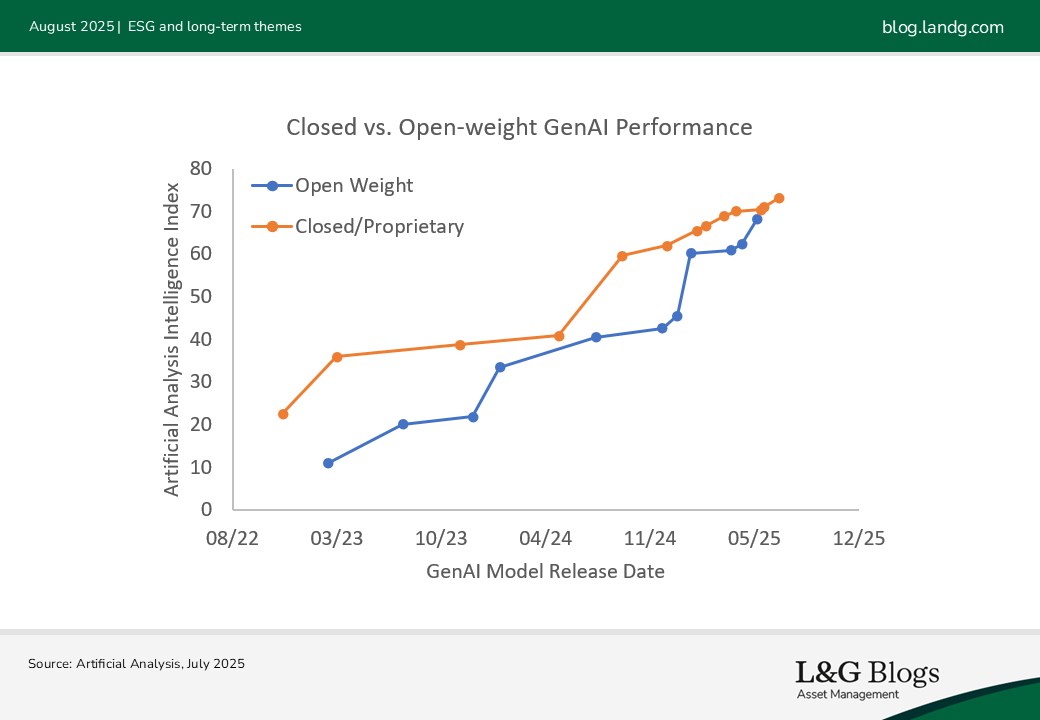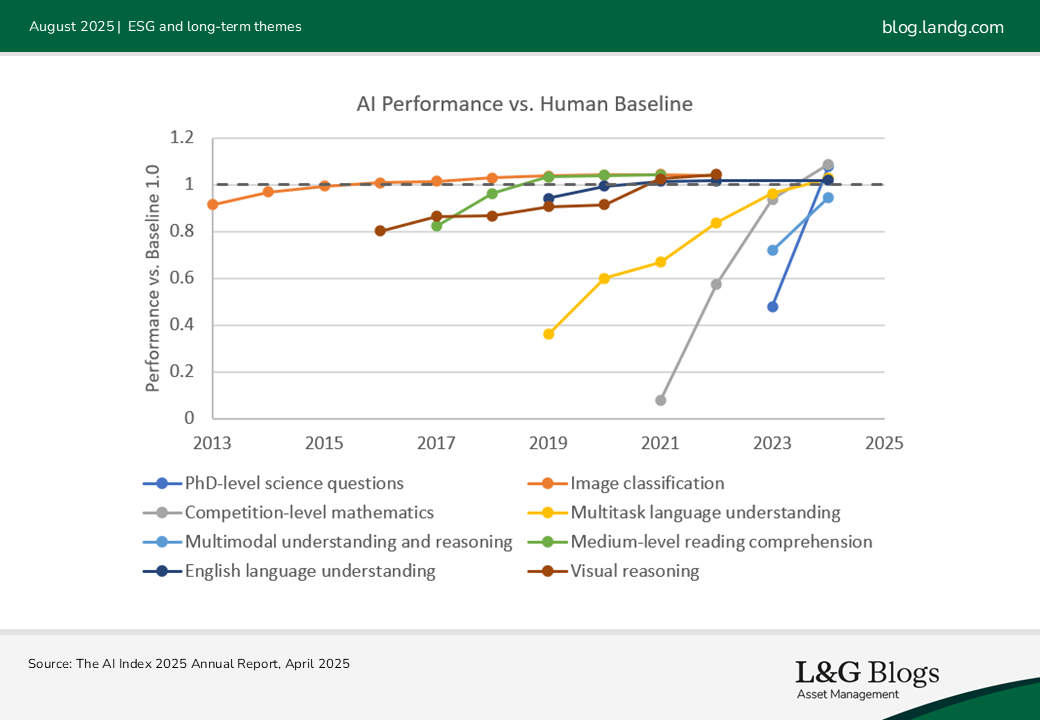Disclaimer: Views in this blog do not promote, and are not directly connected to any L&G product or service. Views are from a range of L&G investment professionals, may be specific to an author’s particular investment region or desk, and do not necessarily reflect the views of L&G. For investment professionals only.
Generative AI in data centres part 3: How GenAI shapes AI sovereignty and data centre investment
In part 1 of this blog series, we introduced the physical infrastructure needs for data centres that support AI. In part 2, we described how those needs could change as AI evolves. In this final instalment, we consider how capital flows for data centre investment are shaped by AI sovereignty and geopolitics, and how the evolution of GenAI will increase their impact.

AI sovereignty – a nation’s control over its AI technologies and infrastructure to ensure data is processed and stored locally – is a growing theme. This deglobalisation of digitalisation has consequences for data centres.
Governments increasingly view domestic AI capabilities as vital for economic competitiveness and national security. The UK’s compute roadmap, for example, seeks to build and enable the development of AI-capable data centres physically located in the UK.[1]
AI sovereignty drives capital demand for AI-ready data centres in underserved regions, for example measured by (AI) data centre power capacity per capita, potentially broadening geographic investment opportunities.
Open models and growing GenAI capabilities enable and necessitate AI sovereignty
AI models generally fall into two categories: closed models, which are proprietary and run on the model maker’s own data centre infrastructure, and open models, which can be downloaded and run independently. With open models, governments and organisations can process data on their own infrastructure, giving them more control over privacy, performance, and sovereignty. This makes high-performing open models a key enabler of AI sovereignty.
While closed models currently perform better than open models in answering questions they’re given, that gap has reduced, enabled by open models from DeepSeek and Meta. In our view, open models could stay competitive in the medium term, further enabling AI sovereignty.

Europe is already moving towards using open-based digital implementations[2],[3], reflecting an effort to reduce reliance on Big Tech. At the same time, 64% of public sector organisations are exploring or developing GenAI initiatives, with 52% concerned about AI sovereignty and 90% planning to adopt AI agents within 2–3 years.[4] As GenAI models advance[5],[6], they’ll handle more complex, sensitive tasks, increasing data use and the need for stronger data protections, accelerating, in our view, the push for AI sovereignty.

Coupling the capital demands with growth in GenAI capabilities is driving European governments to announce significant investments in building domestic AI infrastructure. This could create potential opportunities in the near term for public-backed private investment in AI-ready data centres.[7]
Hyperscalers are aligning with sovereign needs and could provide more private investment opportunities
US-based hyperscalers recognise Europe's push for digital sovereignty. After geopolitical tensions, Microsoft committed to supporting European cloud providers, respecting digital laws, offering open-source AI platforms, increasing data centre capacity by 40% over two years, and ensuring customer data stays in Europe.[8],[9] Alignment with European objectives may enhance demand for AI-ready data centres in Europe by increasing private investment opportunities in build-to-suit developments, potentially driving greater leasing activity and rental growth across the region.
While government-backed initiatives – including public-private partnerships – could spur investment, the scale of US-based hyperscalers means they are likely to play a major role in developing local data centre capacity to meet European governments’ AI sovereign push. We believe there will also be opportunities for European colocation providers in expanding their platforms through new developments, particularly once the hyperscalers have established zones of AI-capable data centre clusters. This may also open opportunities for private investors to fund that platform buildout.
US tech firms are leading the development of GenAI models and are building capital-intensive multi-GW-scale data centres to support future innovation. While Europe has announced similar projects, it lacks a domestic hyperscaler and a competitive environment for talent while facing greater capital constraints. This increases reliance on US hyperscalers to fund and operate European AI infrastructure. Due to these limitations alongside competitive US-trained open models, we believe Europe is less likely to host the largest AI training facilities. Instead, demand may shift toward lower-power inference data centres with lower (though still significant) capital barriers, creating more geographically diversified investment opportunities for private capital in developing AI-capable data centres located in Europe.
Investment implications round-up
GenAI is driving strong demand for data centres, but the pace and scale of that growth is still to be determined. Investors can gain exposure through AI-capable facilities, but careful asset selection is key to managing long-term risk.
To manage uncertainty in GenAI demand, investors should carefully consider whether data centres built for AI can also be adaptable enough to support other uses like cloud computing. This enables diversification*, helping to balance growth potential with long-term resilience.
Training GenAI models requires high-power, remote data centres with high capital costs and limited adaptability. These assets may offer stable income if leased long-term to a hyperscaler, but they carry higher obsolescence and exit risk, so selectivity is key.
As GenAI adoption grows, demand is shifting from training to inference. Inference-ready data centres are more adaptable, with locations and connectivity that suit a wider range of tenants. This makes them more resilient and better positioned for long-term investor returns, in our view.
Both training and inference need liquid cooling to run the latest AI chips. Investors should focus on high-spec facilities that support these chips and can be upgraded over time to reduce obsolescence risk and protect long-term value.
New AI-native firms (e.g., neoclouds) are expanding and adding diversity to the tenant base, which is a positive for investors. Their credit quality is rapidly improving but still frequently lower than incumbents, and careful consideration should be taken on lease terms. Investors should balance these opportunities with more established tenants to manage credit risk and cash flow volatility.
AI sovereignty is driving demand for local data centres, especially in Europe. With governments pushing for domestic infrastructure and US hyperscalers expanding to meet that need, investors have growing opportunities in inference-ready and colocation platforms across the region.
While the future of GenAI and its impact on data centres is complex, uncertain, and still unfolding, one thing is clear to us: understanding how AI is evolving, and what that means for digital infrastructure, is becoming essential for investors. As this space grows, informed asset selection will be key to capturing opportunity while managing risk.
The value of an investment and any income taken from it is not guaranteed and can go down as well as up, and the investor may get back less than the original amount invested.
[1] UK Compute Roadmap - GOV.UK, July 2025
[2] For a digitally independent Europe, IONOS Newsroom (UK), March 2025
[3] One of France's largest cities has now also ditched Microsoft for open source software, TechRadar, June 2025
[4] Data foundations for government_From AI ambition to execution_Public Sector, May 2025
[5] Measuring AI Ability to Complete Long Tasks, March 2025
[6] “The AI Index 2025 Annual Report,” AI Index Steering Committee, Institute for Human-Centered AI, Stanford University, Stanford, CA, April 2025
[7] State of the Digital Decade 2025: Keep building the EU's sovereignty and digital future, European Commission, June 2025
[8] Microsoft announces new European digital commitments, Microsoft, April 2025
[9] Announcing comprehensive sovereign solutions empowering European organizations, Microsoft, June 2025
Recommended content for you
Learn more about our business
We are one of the world's largest asset managers, with capabilities across asset classes to meet our clients' objectives and a longstanding commitment to responsible investing.

